A Study on Karst Cave Collapse Based on Improved Terzaghi Theory and Upper Limit Analysis
Abstract
:1. Introduction
2. Basic Theories
2.1. Protodyakonov’s Pressure Arch Theory
2.2. Improved Terzaghi Theory
- (1)
- The groundwater table lies beneath the karst cave
- (2)
- The groundwater table is above the karst cave.
2.3. Limit Analysis Method
- (1)
- Groundwater table below karst cave
- (2)
- Groundwater table above karst cave
3. Case Study
3.1. Case Description
3.2. Numerical Simulation
3.3. Stability Analysis of the Karst Cave
- (1)
- Protodyakonov’s pressure arch theory
- (2)
- Improved Terzaghi theory
- (3)
- Limit analysis method
4. Discussion
4.1. Comparison with the Numerical Solution
4.2. Parameter Analysis
4.2.1. Effect of Karst Cave Development
4.2.2. Effect of Shear Strength of the Soil
4.2.3. Effect of Groundwater Table and Boundary Failure Angle
5. Conclusions
- (1)
- The improved Terzaghi theory focuses on karst caves and their overburden, whereas the limit analysis method focuses only on the overburden. Consequently, the results of the improved Terzaghi theory are lower than those of the limit analysis method. Moreover, the difference between them increases with an increase in the diameter of karst cave d;
- (2)
- For karst caves, the overburden thickness h is proportional to their stability, while the diameter of the karst cave d is inversely proportional to their stability. Additionally, the shear strength of soil (c and φ) is proportional to their stability. When the groundwater table is regarded as stable, the effect of groundwater level z1 on the stability of karst caves is limited and the stability of karst caves decreases as boundary failure angle α or β increases.
Author Contributions
Funding
Institutional Review Board Statement
Informed Consent Statement
Data Availability Statement
Conflicts of Interest
References
- Jurkovšek, B.; Biolchi, S.; Furlani, S.; Kolar-Jurkovšek, T.; Zini, L.; Jež, J.; Tunis, G.; Bavec, M.; Cucchi, F. Geology of the classical karst region (SW Slovenia–NE Italy). J. Maps 2016, 12 (Suppl. S1), 352–362. [Google Scholar] [CrossRef]
- Stevanović, Z. Karst waters in potable water supply: A global scale overview. Environ. Earth Sci. 2019, 78, 662. [Google Scholar] [CrossRef]
- De Waele, J.; Plan, L.; Audra, P. Recent developments in surface and subsurface karst geomorphology: An introduction. Geomorphology 2009, 106, 1–8. [Google Scholar] [CrossRef]
- Delle Rose, M.; Federico, A.; Parise, M. Sinkhole genesis and evolution in Apulia, and their interrelations with the anthropogenic environment. Nat. Hazard. Earth Syst. Sci. 2004, 4, 747–755. [Google Scholar] [CrossRef]
- Heidari, M.; Khanlari, G.; Beydokhti, A.T.; Momeni, A. The formation of cover collapse sinkholes in North of Hamedan, Iran. Geomorphology 2011, 132, 76–86. [Google Scholar] [CrossRef]
- Pando, L.; Pulgar, J.A.; Gutiérrez-Claverol, M. A case of man-induced ground subsidence and building settlement related to karstified gypsum (Oviedo, NW Spain). Environ. Earth Sci. 2013, 68, 507–519. [Google Scholar] [CrossRef]
- Kamran, M.; Hu, X.; Hussain, M.A.; Sanaullah, M.; Ali, R.; He, K. Dynamic Response and Deformation Behavior of Kadui-2 Landslide Influenced by Reservoir Impoundment and Rainfall, Baoxing, China. J. Earth Sci. 2023, 34, 911–923. [Google Scholar] [CrossRef]
- Jiang, F.; Dai, J.; Lei, M.; Qin, Y.; Jiang, X.; Meng, Y. Experimental study on the critical triggering condition of soil failure in subsidence sinkholes. Environ. Earth Sci. 2015, 74, 693–701. [Google Scholar] [CrossRef]
- Jeong, S.W.; Yum, B.W.; Ryu, D.W.; Lee, H.J.; Jung, B. The influence of clay content on cave-ins in tank model tests and monitoring indicators of sinkhole formation. Appl. Sci. 2019, 9, 2346. [Google Scholar] [CrossRef]
- Chen, X.; Gao, X.; Li, H.; Xue, M.; Gan, X.; Song, Y. Model test analysis of groundwater level fluctuations on Karst cover deformation taking the monolithic structure of Guilin as an example. Appl. Sci. 2023, 13, 1747. [Google Scholar] [CrossRef]
- Tan, F.; Tan, W.; Yan, F. Model test analysis of subsurface cavity and ground collapse due to broken pipe leakage. Appl. Sci. 2022, 12, 13017. [Google Scholar] [CrossRef]
- Parise, M.; Lollino, P. A preliminary analysis of failure mechanisms in karst and man-made underground caves in Southern Italy. Geomorphology 2011, 134, 132–143. [Google Scholar] [CrossRef]
- Ma, D.; Bai, H.; Wang, Y. Mechanical behavior of a coal seam penetrated by a karst collapse pillar: Mining-induced groundwater inrush risk. Nat. Hazards 2015, 75, 2137–2151. [Google Scholar] [CrossRef]
- Guo, L.; Wang, S.; Sun, L.; Kang, Z.; Zhao, C. Numerical simulation and experimental studies of karst caves collapse mechanism in fractured-vuggy reservoirs. Geofluids 2020, 2020, 8817104. [Google Scholar] [CrossRef]
- Mao, W.; Li, W.; Rasouli, R.; Ahmad, N.; Zheng, H.; Huang, Y. Numerical Simulation of Liquefaction-Induced Settlement of Existing Structures. J. Earth Sci. 2023, 34, 339–346. [Google Scholar] [CrossRef]
- Hatzor, Y.H.; Wainshtein, I.; Mazor, D.B. Stability of shallow karstic caverns in blocky rock masses. Int. J. Rock Mech. Min. Sci. 2010, 47, 1289–1303. [Google Scholar] [CrossRef]
- Likitlersuang, S.; Keawsawasvong, S.; Tanapalungkorn, W. Undrained stability analysis of spherical cavities in non-homogeneous clay. Transp. Infrastruct. Geotechnol. 2023, 11, 152–170. [Google Scholar] [CrossRef]
- Hartmann, A.; Goldscheider, N.; Wagener, T.; Lange, J.; Weiler, M. Karst water resources in a changing world: Review of hydrological modeling approaches. Rev. Geophys. 2014, 52, 218–242. [Google Scholar] [CrossRef]
- Jiang, C.; Zhao, M.; Cao, W. Stability analysis of subgrade cave roofs in karst region. J. Cent. South Univ. Tech. 2008, 15, 38–44. [Google Scholar] [CrossRef]
- Jia, L.; Li, L.; Meng, Y.; Wu, Y.; Pan, Z.; Yin, R. Responses of cover-collapse sinkholes to groundwater changes: A case study of early warning of soil cave and sinkhole activity on Datansha Island in Guangzhou, China. Environ. Earth Sci. 2018, 77, 488. [Google Scholar] [CrossRef]
- Augarde, C.E.; Lyamin, A.V.; Sloan, S.W. Prediction of undrained sinkhole collapse. J. Geotech. Geoenviron. Eng. 2003, 129, 197–205. [Google Scholar] [CrossRef]
- Keawsawasvong, S.; Ukritchon, B. Undrained stability of a spherical cavity in cohesive soils using finite element limit analysis. J. Rock Mech. Geotech. Eng. 2019, 11, 1274–1285. [Google Scholar] [CrossRef]
- Liu, Z.; Cao, P.; Wang, F.; Meng, J.; Cao, R.; Liu, J. Three-dimensional upper bound limit analysis of tunnel stability with an extended collapse mechanism. KSCE J. Civ. Eng. 2022, 26, 5318–5327. [Google Scholar] [CrossRef]
- Liu, Z.-Z.; Cao, P.; Lin, H.; Meng, J.-J.; Wang, Y.-X. Three-dimensional upper bound limit analysis of underground cavities using nonlinear Baker failure criterion. Trans. Nonferr. Metal. Soc. China 2020, 30, 1916–1927. [Google Scholar] [CrossRef]
- Hu, Z.; Zhang, J.; Yang, Y.; Wang, Z.; Xie, Y.; Qiu, J.; He, S.; Wang, X. Study on the surrounding rock pressure characteristics of loess tunnel based on statistical analysis in China. Appl. Sci. 2022, 12, 6329. [Google Scholar] [CrossRef]
- He, K.; Liu, C.; Wang, S. Karst collapse related to over-pumping and a criterion for its stability. Environ. Geol. 2003, 43, 720–724. [Google Scholar] [CrossRef]
- Kezdi, A. Lateral earth pressure. In Foundation Engineering Handbook; ASCE Press: Alexander Bell Drive Reston, VA, USA, 1975. [Google Scholar]
- Zhang, R.; Chen, G.; Zou, J.; Zhao, L.; Jiang, C. Study on roof collapse of deep circular cavities in jointed rock masses using adaptive finite element limit analysis. Comput. Geotech. 2019, 111, 42–55. [Google Scholar] [CrossRef]
- Jafari, P.; Fahimifar, A. Upper-Bound face stability analysis of rectangular shield-driven tunnels in undrained clays. Comput. Geotech. 2022, 146, 104739. [Google Scholar] [CrossRef]
- Zhou, P.; Zhou, P. Finite difference method. In Numerical Analysis of Electromagnetic Fields; Springer: Berlin/Heidelberg, Germany, 1993; pp. 63–94. [Google Scholar]
- Keawsawasvong, S. Limit analysis solutions for spherical cavities in sandy soils under overloading. Innov. Infrastruct. Solut. 2021, 6, 33. [Google Scholar] [CrossRef]
- Xiong, Q.; Zeng, J.; Wang, R.; Wang, W.; Li, J.; Yang, C.; Tao, L. Study on the genesis and mechanical model of karst collapse in the first-order terrace of Wuhan Yangtze river. Resour. Environ. Eng. 2020, 34, 408. [Google Scholar]
- Zhao, Y.; Shi, Y.; Wu, F.; Sun, R.; Feng, H. Characterization of the sinkhole failure mechanism induced by concealed cave: A case study. Eng. Fail. Anal. 2021, 119, 105017. [Google Scholar] [CrossRef]
- Shiau, J.; Chudal, B.; Keawsawasvong, S. Three-dimensional sinkhole stability of spherical cavity. Acta Geotech. 2022, 17, 3947–3958. [Google Scholar] [CrossRef]
- Zhao, L.; Huang, S.; Zhang, R.; Zuo, S. Stability analysis of irregular cavities using upper bound finite element limit analysis method. Comput. Geotech. 2018, 103, 1–12. [Google Scholar] [CrossRef]
- Zhao, Y.; Li, X.; Tai, P.; Huang, L.; Pu, B.; Chen, R. Upper bound limit analysis of roof collapse of deep cavities in unsaturated soils. Int. J. Numer. Anal. Met. Geomech. 2022, 46, 1224–1240. [Google Scholar] [CrossRef]
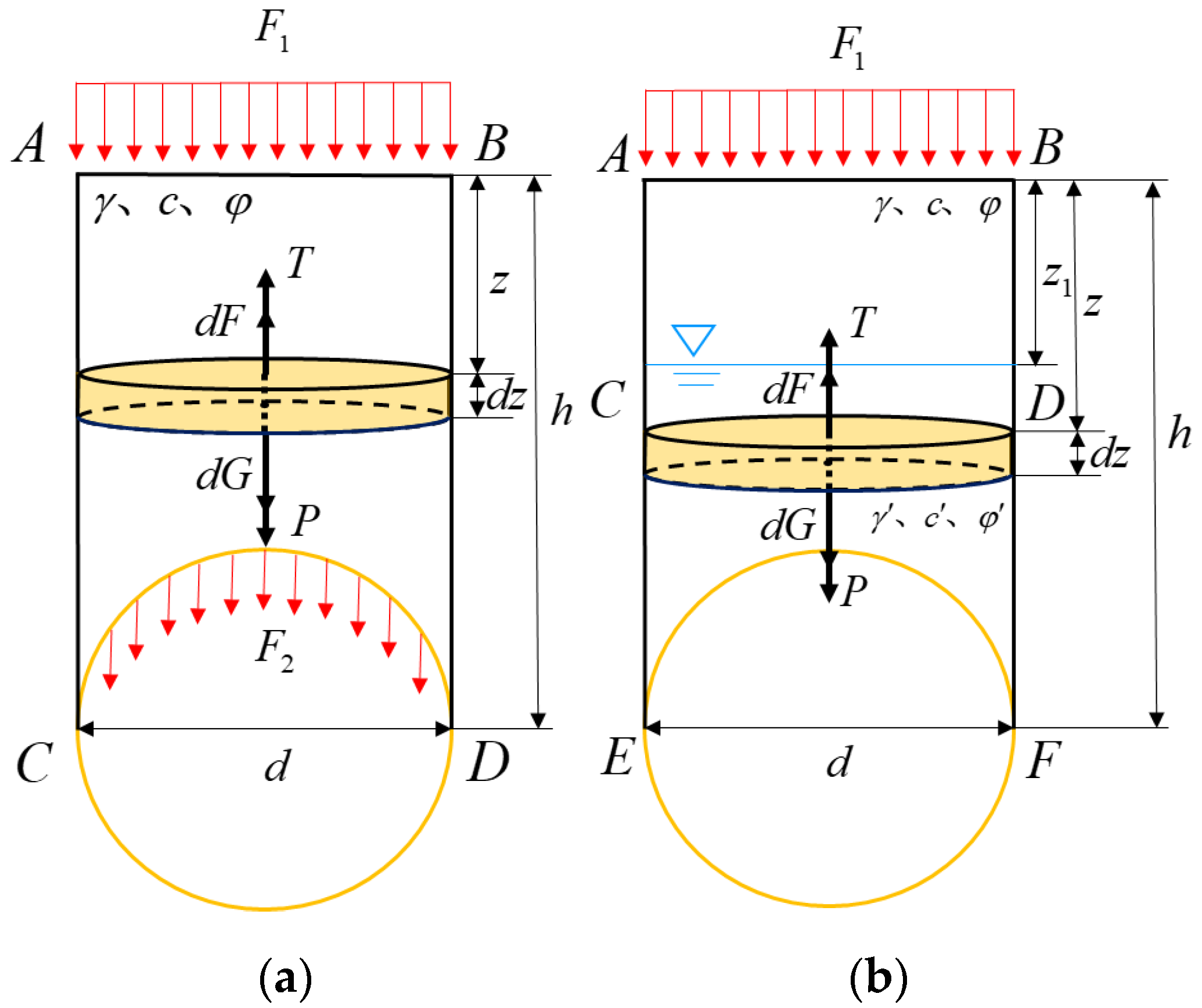
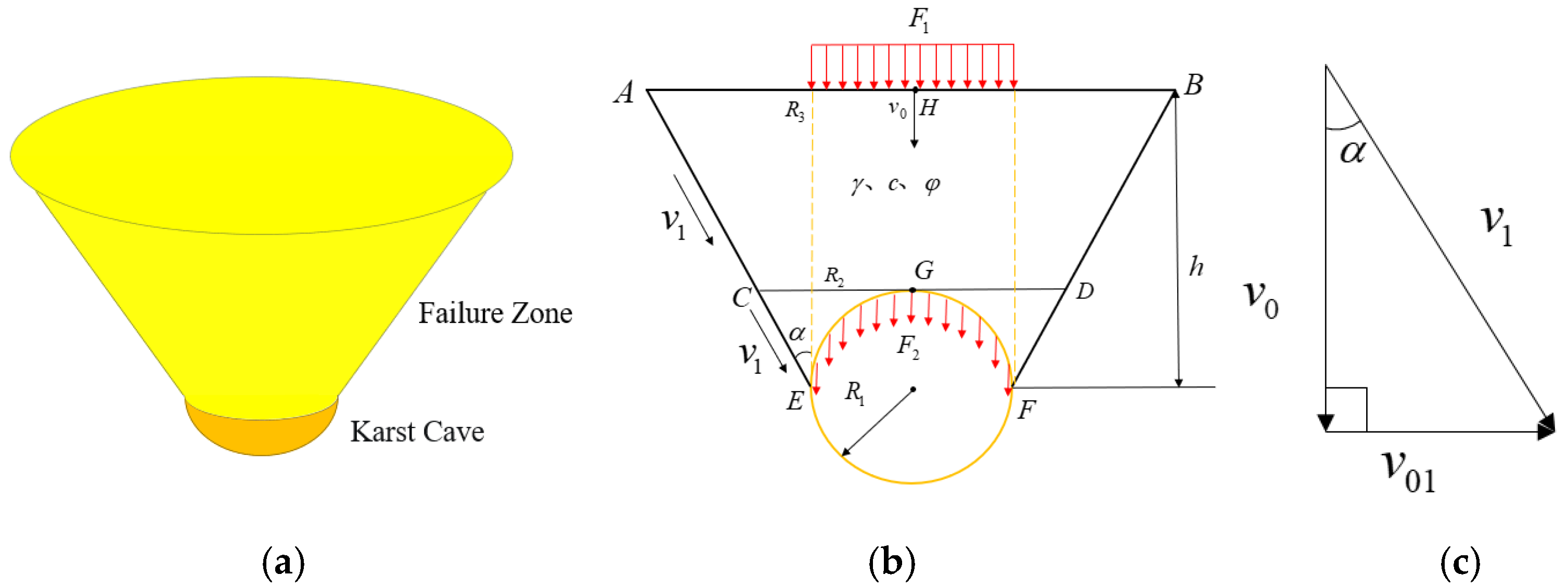

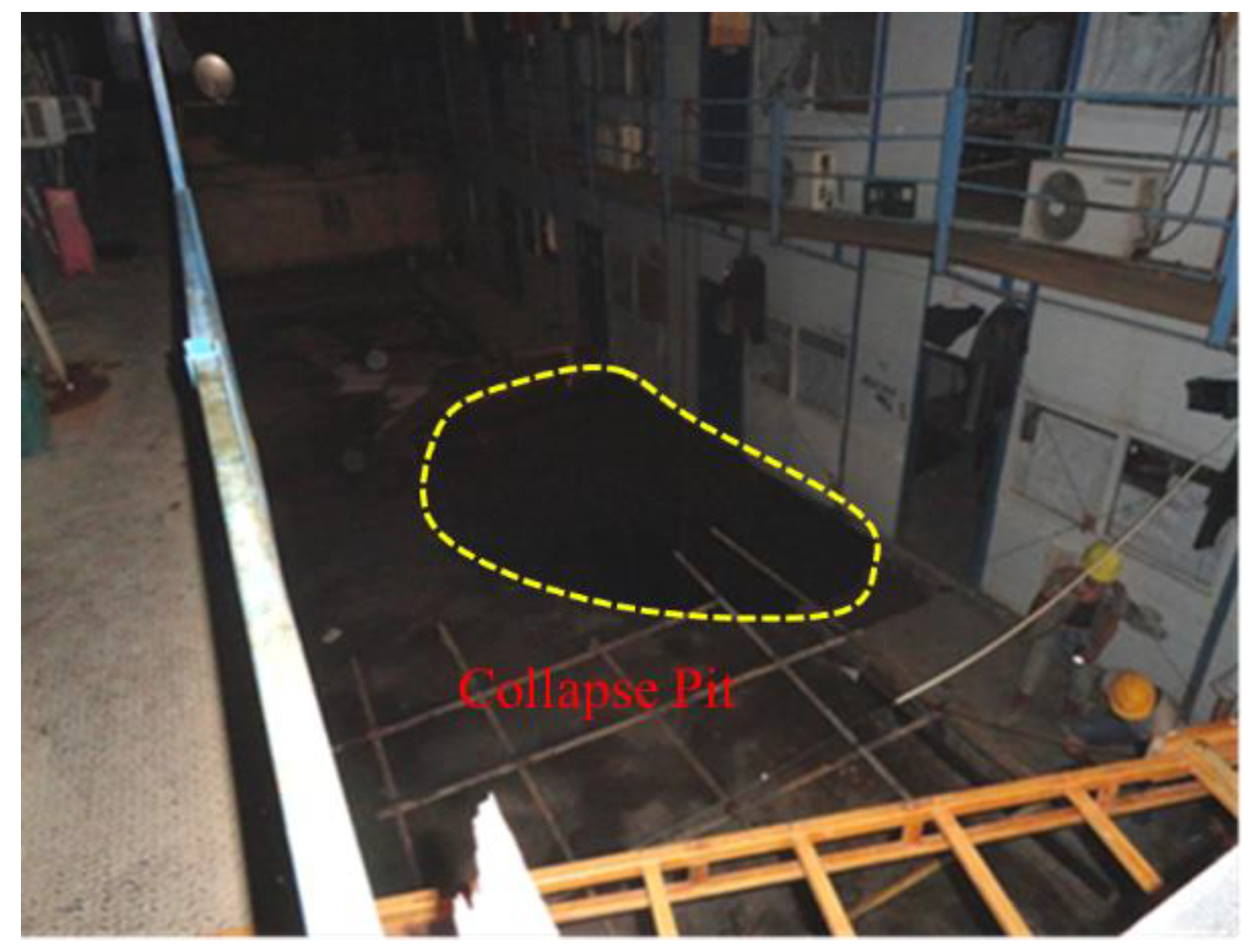


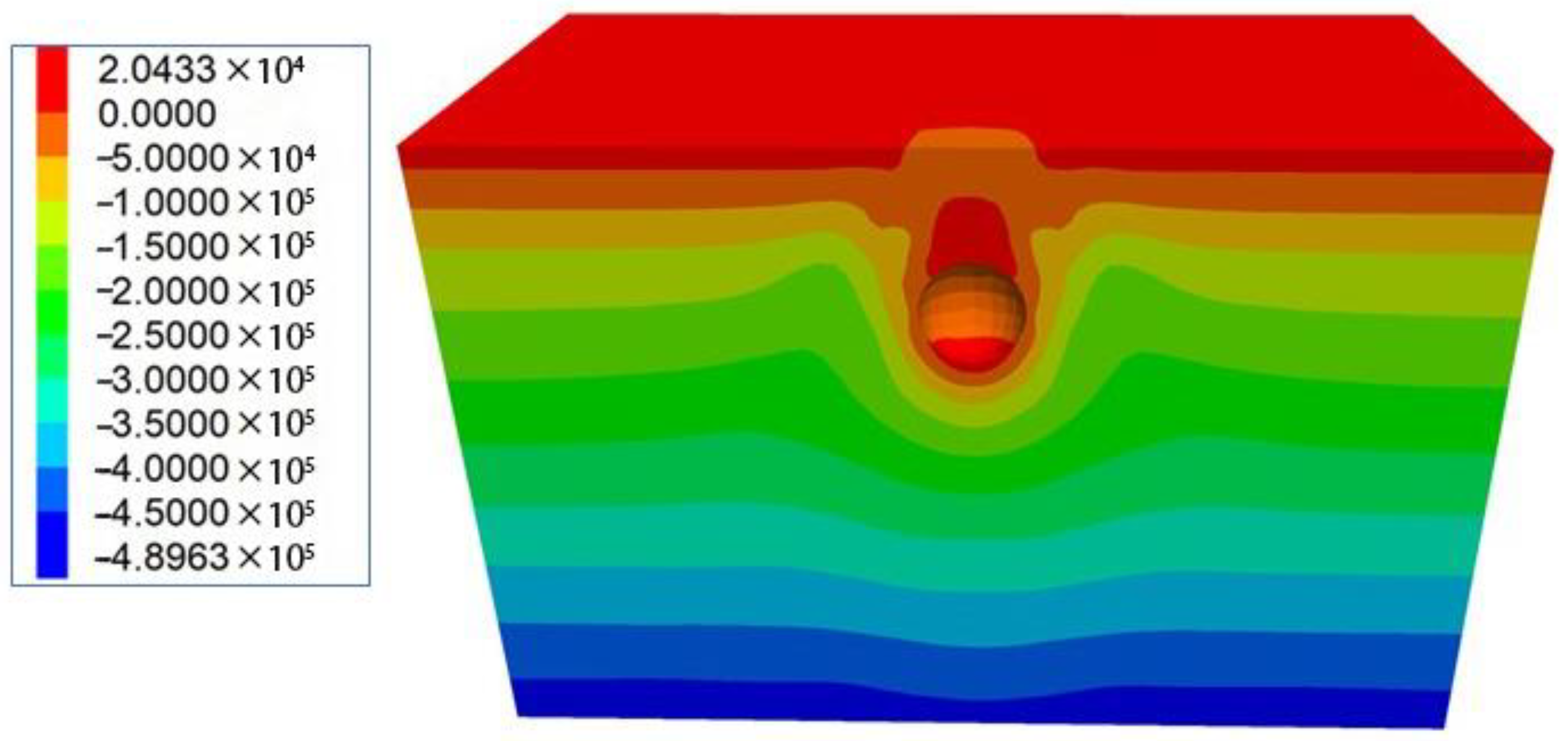
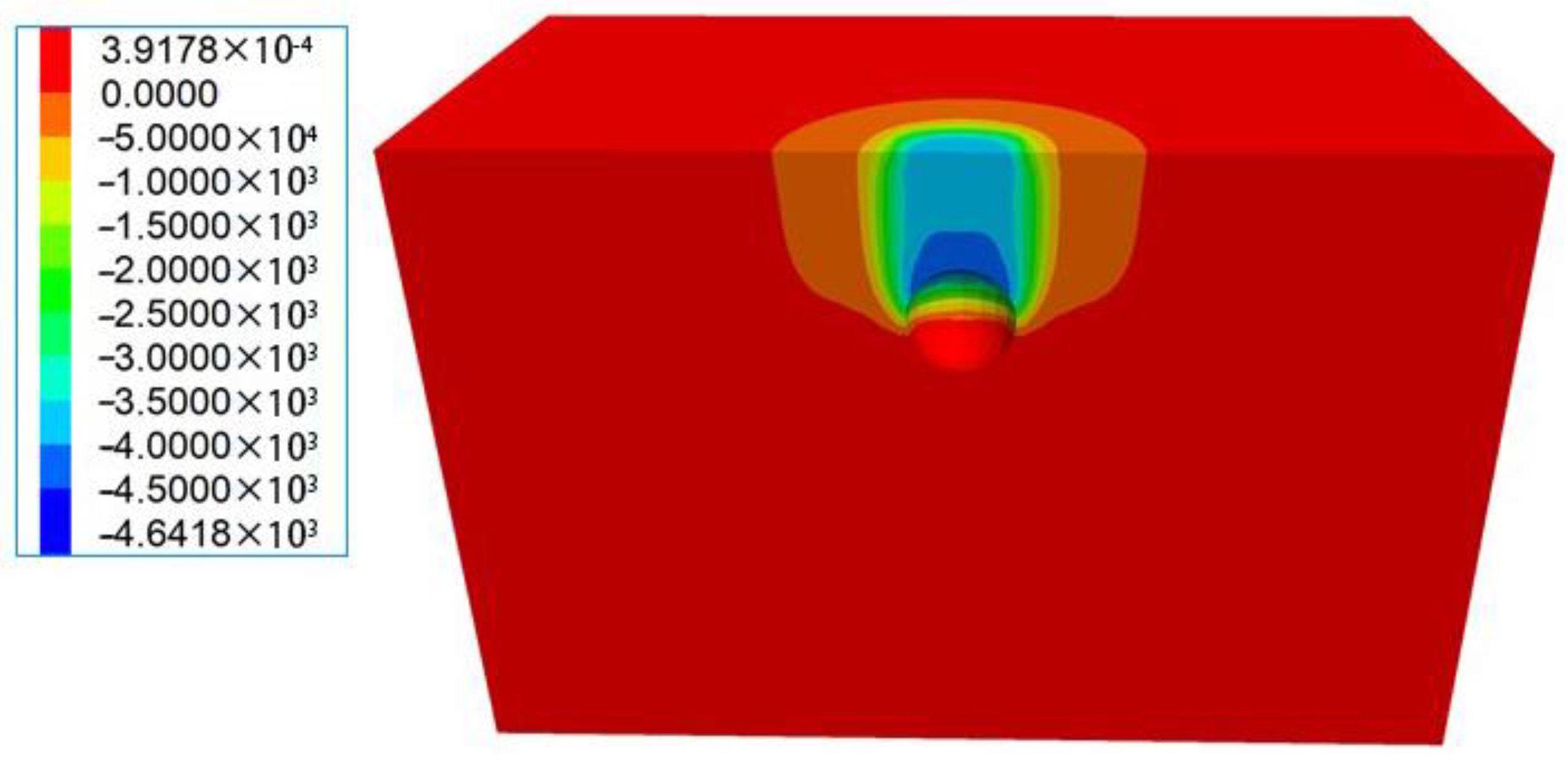
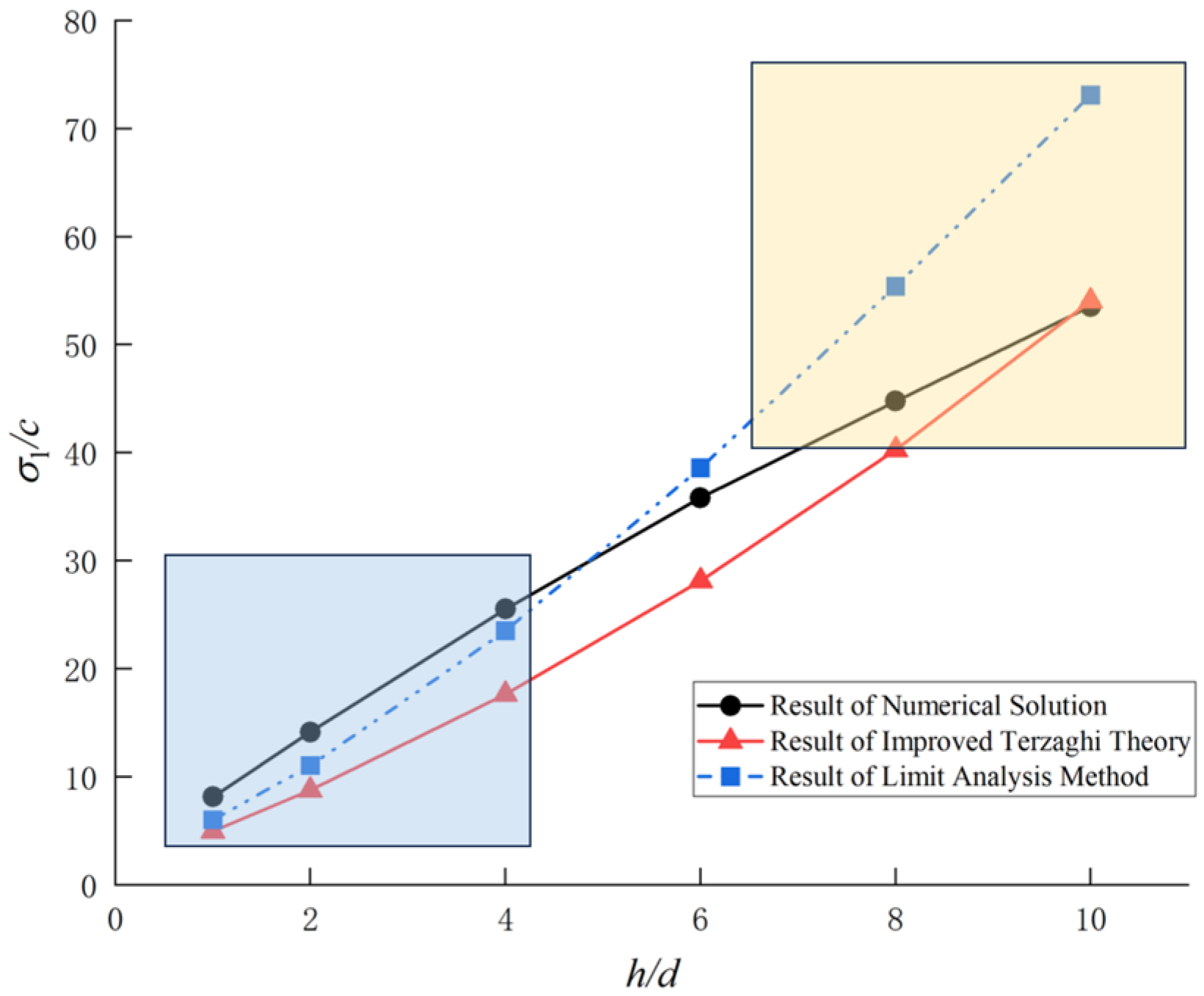
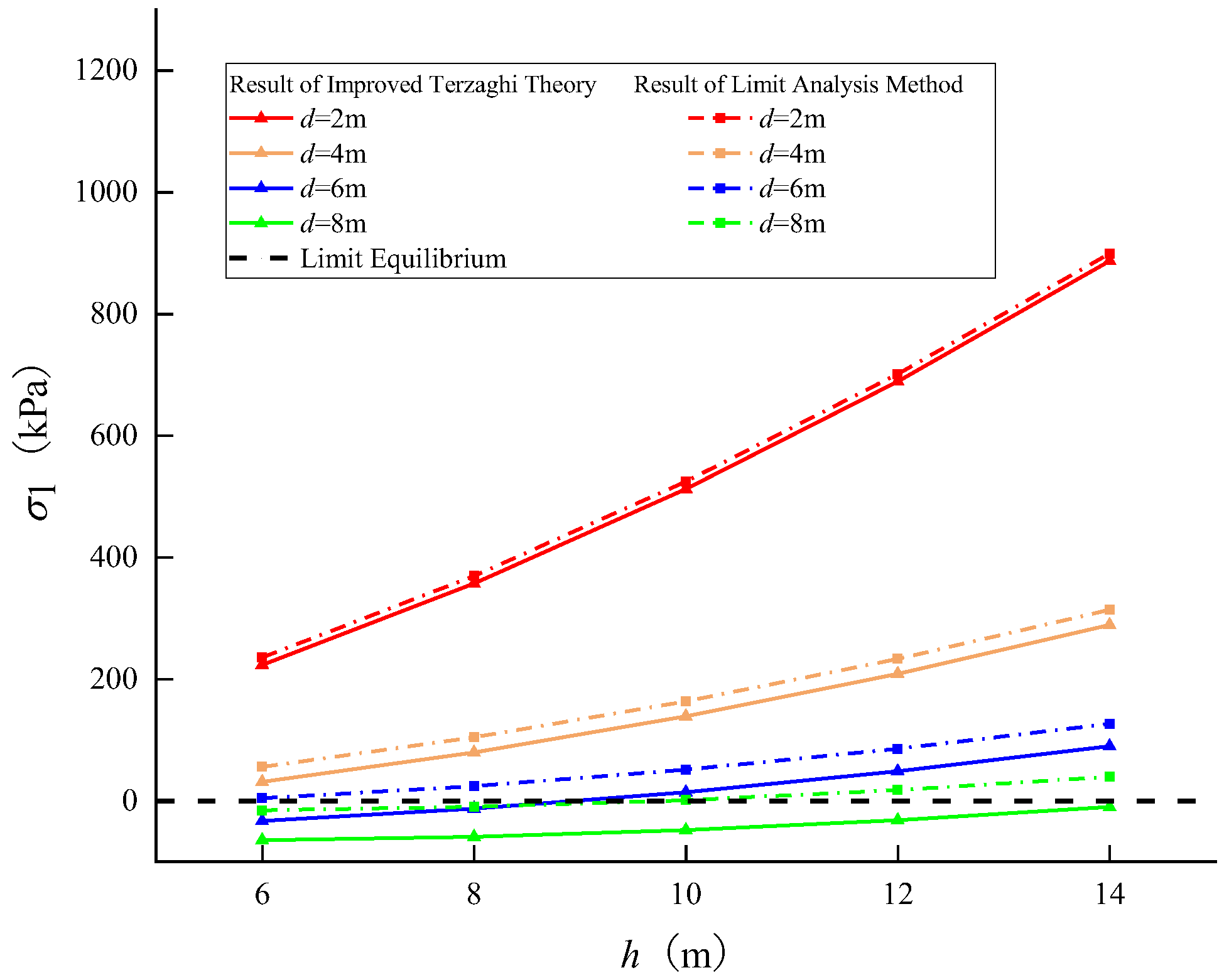


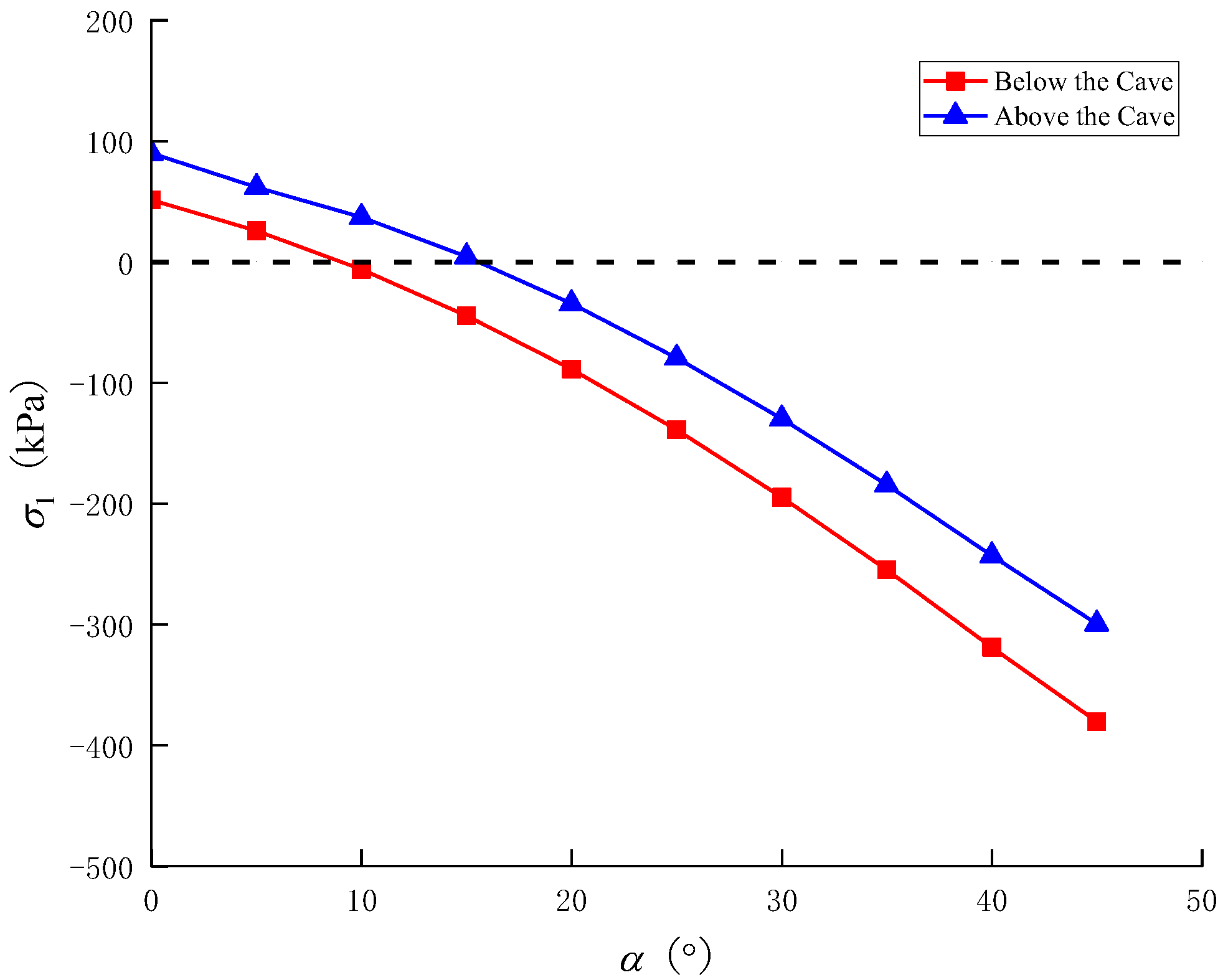
| Diameter of karst cave d/m | 7 |
| Overburden height h/m | 11 |
| Cohesion of natural soil c/kPa | 24 |
| Internal friction angle of natural soil φ/° | 14 |
| Unit weight of natural soil γ/(kN/m3) | 18.5 |
| Cohesion of saturated soil c´/kPa | 19.2 |
| Internal friction angle of saturated soil φ´/° | 11.2 |
| Unit weight of saturated soil γ´/(kN/m3) | 9.5 |
Disclaimer/Publisher’s Note: The statements, opinions and data contained in all publications are solely those of the individual author(s) and contributor(s) and not of MDPI and/or the editor(s). MDPI and/or the editor(s) disclaim responsibility for any injury to people or property resulting from any ideas, methods, instructions or products referred to in the content. |
© 2024 by the authors. Licensee MDPI, Basel, Switzerland. This article is an open access article distributed under the terms and conditions of the Creative Commons Attribution (CC BY) license (https://creativecommons.org/licenses/by/4.0/).
Share and Cite
Yan, W.; Liu, R.; Tian, S.; Tan, F.; Wen, H.; Lv, J. A Study on Karst Cave Collapse Based on Improved Terzaghi Theory and Upper Limit Analysis. Appl. Sci. 2024, 14, 8252. https://doi.org/10.3390/app14188252
Yan W, Liu R, Tian S, Tan F, Wen H, Lv J. A Study on Karst Cave Collapse Based on Improved Terzaghi Theory and Upper Limit Analysis. Applied Sciences. 2024; 14(18):8252. https://doi.org/10.3390/app14188252
Chicago/Turabian StyleYan, Weilong, Rui Liu, Shugao Tian, Fei Tan, Hao Wen, and Jiahe Lv. 2024. "A Study on Karst Cave Collapse Based on Improved Terzaghi Theory and Upper Limit Analysis" Applied Sciences 14, no. 18: 8252. https://doi.org/10.3390/app14188252







